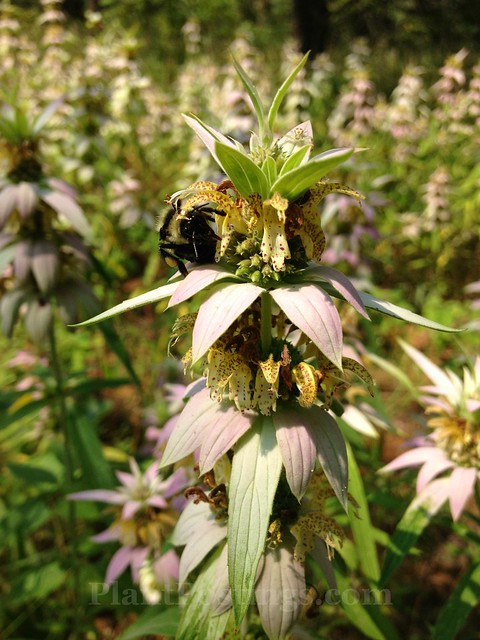
Have you ever spent 30 minutes simply watching pollinators? If not, I highly recommend it. It's calming, it's fun; plus, it puts you in touch with nature at a very basic level.
Better yet, how about spending those 30 minutes (shorter or longer times are fine, too) counting and documenting the numbers and types of pollinators you see for The Great Sunflower Project? If you feel you need a reason to sit and watch your garden visitors, this will give you a purpose and a mission! Citizen science at its best!
The website explains, in detail, how to start, what they want you to track, and how to record it. Five minutes appears to be the minimum time requirement, probably to make the data valid. And you can choose to observe one plant, a grouping of plants, or a larger area. (The plants don't need to be Sunflowers.) Based on my limited experience, it's easier to track activity on one plant or a small grouping of plants.
You don't have to be a pollinator expert! I, certainly, am not. But there are pollinator categories to choose. The project asks you to document as specifically as you can, and to avoid specifics if you aren't sure.
I've reported through the Great Sunflower Project twice--both times last summer. The second time, I chose to watch the same plant for 30 minutes.

I chose Spotted Beebalm (Monarda punctata). In mid- and late summer, we had meadows full of this native wildflower blooming on our property up at our cottage. And they were covered in pollinators of all types--from bees to butterflies to hummingbirds.
After I finished tracking and documenting for the Great Sunflower Project, I took a few photos and captured some video.
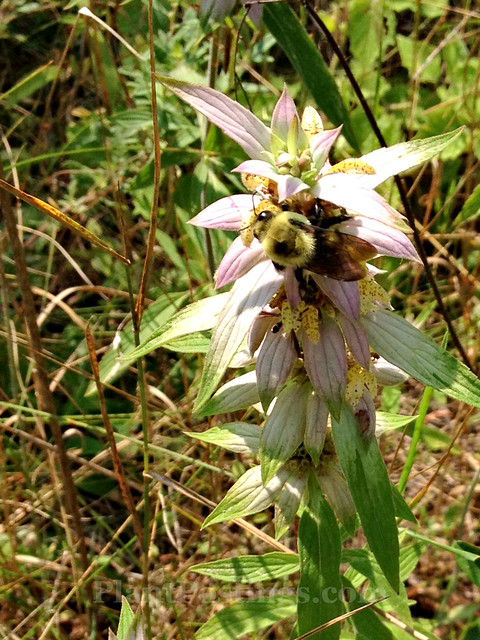
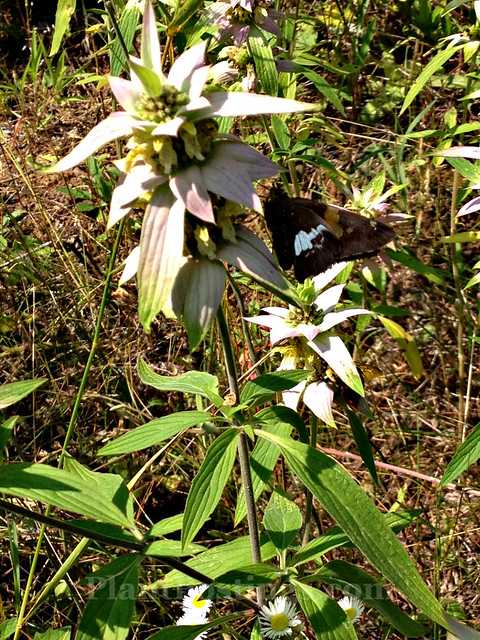
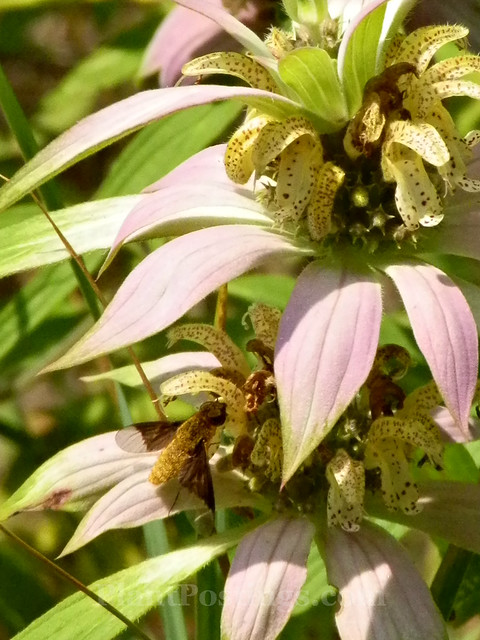

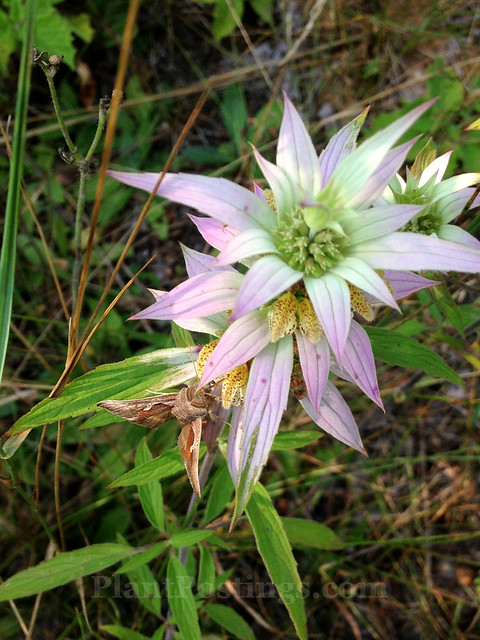
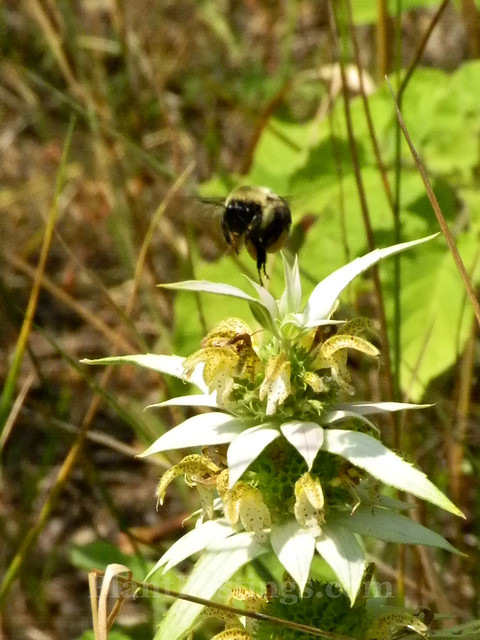
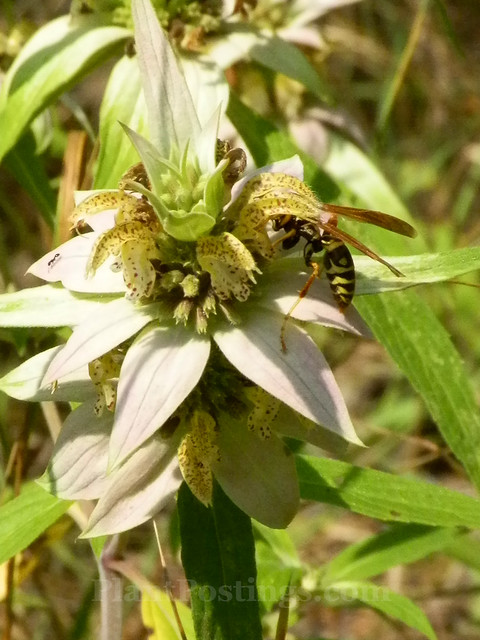
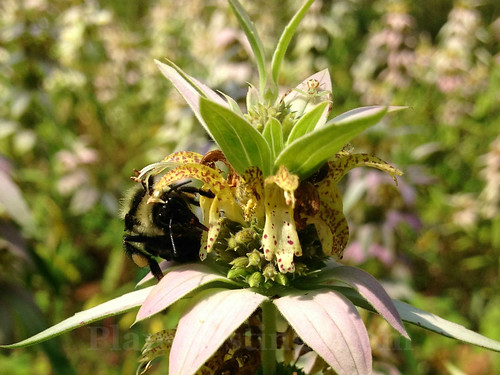
Just recently I played around with the video segments to make a very simple presentation to share. Note that the pollinators are flying fast, and this is not fast-motion video. (You can enlarge it by clicking on "full screen" or watch it on YouTube.)
It's just a quick glance to show how the pollinators enjoyed that Monarda punctata. What a joyful sight!
* * * * * * * * *
I'm linking this post with Donna's Seasonal Celebrations at Gardens Eye View. Do head on over to see what other gardeners look forward to in the season ahead.
I'll also link in with Gail's Wildflower Wednesday, which appears on the fourth Wednesday of each month. Check it out!
Oh my Beth that meadow of Spotted Beebalm is heavenly...who wouldn't want to just stand there and gaze at the beauty and listen the buzz and hum of those happy pollinators...I did this Project one summer with Scarlet Beebalm. I should try again this year. Thanks for the reminder....stunning photos and I love the video.
ReplyDeleteAs always thank you for supporting Seasonal Celebrations!
Thanks, Donna, and thanks for collaborating! The planets aligned last summer and we were at the cottage during the peak of pollinator activity on the Monardas. I thought I had died and gone to heaven! (Perhaps an exaggeration, but I was ecstatic.) Next time, I hope to remember to bring along a tripod and work with the settings on the camera for better video. I couldn't believe how many pollinators of so many types I saw on those plants that day. Made my heart sing! :)
DeleteI have sat and watched pollinators often, Beth. They are so fascinating. Monarda is a good plant for them. There are quite a few plants in the garden that serve the generalist pollinators, and one is on my next post coincidentally. I wish I could have every plant in our area that pollinators use, but sadly the space is far too small.
ReplyDeleteI know you have some amazing photos of pollinators, Donna, and I'm awestruck every time I visit your blog! I'll be visiting soon to learn about the plants you will highlight. Cheers!
DeleteLove watching pollinators, Beth :)
ReplyDeleteI think it's fascinating how the bees will race through some flowers (e.g., Hypericum frondosum 'Sunburst') and take their time picking through others (e.g. Vitex agnus-castus, Echinacea purpurea)
Thanks for the photos. You've definitely encouraged me to take a closer look at Monarda punctata!
Yes! And I think it's fun to compare the numbers and types of pollinators on different plants in the same small area to see their preferences. In this case, the Monardas were swarming with everything! It was a warm (80s) summer day and they were very happy (and so was I). :)
DeleteI like to watch and do it, the insects at work. However, half an hour did before. Very interesting and nice movie. Regards.
ReplyDeleteSometimes I find it hard to justify idle time. Although it is beneficial to peacefulness and mental health. But it's surprising how concentrated one needs to be to actually track and count pollinators--especially when there are so many on one plant!
Deletethat is a beautiful flower with a facinating structure. The layers of flowers. I wonder if it is related to our Leonotis.
ReplyDeleteHi Diana: It's a beautiful plant, yes, but personally I also think it's bizarre. The flowers and bracts remind me of the tops of pineapples. I looked up Leonotis (lovely plant, too!), and, yes, they are in the same family: Lamiaceae or Mint family. Do Leonotis have a pleasant scent?
DeleteThe video really shows just how busy all these pollinators are! I was feeling a little guilty at the beginning that I never planted the packet of sunflower seeds I had, so I'm glad to know any pollinator-friendly plant will do for this project.
ReplyDeleteHi Rose: I know...I was glad to find out from a fellow master naturalist that you can track other plants besides Sunflowers. As much as I love Sunflowers, I don't have any here (and very few, small ones at the cottage). It's a fun project!
DeleteThat's so interesting! How many time I grow sunflower, and all was fail. And the beebalm is so pretty. Thank you for sharing.
ReplyDeleteYou're most welcome, Endah. I love Sunflowers, too, but I don't have any in my gardens. The Spotted Beebalm was so plentiful and healthy last summer, it seemed like a natural plant to track. Thanks for stopping by!
DeleteThey do like this plant.. and so many different kinds of insects visiting, very interesting...
ReplyDeleteAmanda xx
Yes, it was amazing. I hope we're at the cottage when the Beebalm blooms again this summer. It was so fun to watch and track!
DeleteWhat a great idea--I've done this, but not officially. You monarda is remarkable--I don't have any and I may need to rectify that! Thanks for this information.
ReplyDeleteThere are many wonderful species of Monarda! The Spotted Beebalm just happens to be the species that blooms naturally up in the meadows at the cottage. The arrangement and color of the flowers and bracts, in rings along the sides of the plant, make it quite fun to watch as the pollinators land and move in for the pollen and nectar. :)
DeleteLove your post. I think that anytime we can spend time really studying something beyond the superficial, our lives are richer. Wonderful to watch pollinators do their thing, as it is something that can save our lives. (Only most people don't know that.) Also amazing to watch the entire process of nesting to fledgling! Once I spent four hours on a porch swing watching each of five baby birds decide to take flight! They each were different, I couldn't believe it. Nature has so much to teach us. Thank you Beth!
ReplyDeleteThanks, Susie! I totally agree. Sometimes I feel an urgent need to do something like this. Seems like humans were created for hard work, yes, but also for contemplation and watchfulness. How fun to watch the baby birds get their wings! Cheers!
DeleteI did not know another name for dotted horsemint was spotted beebalm. Excellent pics! I love this alien-looking plant.
ReplyDeleteYep, they're two nicknames for the same plant! Thanks! I was hesitant with this plant at first, I must admit. It's kind of strange-looking. But after seeing how much the pollinators like it, and seeing it en masse among a few other wildflowers in a meadow, I've come to truly appreciate it. I even think it's beautiful in its own way. Works well with Daisy-like flowers. And Liatris. And it smells wonderful!
DeleteThanks so much for sharing this! I've done the backyard bird count, this seems like an excellent extension of the same idea. I love watching the flying insects on the flowers anyway, and this may help me to identify more of the critters I am seeing.
ReplyDeleteYou're welcome, Jason. This seems like an activity you would enjoy. :) It was fun, although it's surprising how hard you have to concentrate to count each pollinator that visits. I also enjoy simply watching the pollinators. I think the next time I do this, I'll try to spend 30 minutes simply enjoying them, and 30 minutes counting them. ;-)
DeleteVery interesting, I hadn't heard of the Great Sunflower Project before! I'm so glad our pollinators are getting more attention - they deserve it!
ReplyDeleteYes, it's a great idea. Seems like it's helpful to identify not only all the pollinators that visit, but also the plants (like the Monarda) that they prefer. This plant seems to support a very wide variety of pollinators.
DeleteI love seeing that huge expanse of Monarda...I had no idea that this plant existed, especially as a wildflower. It's gorgeous and I can see the resemblance to what we plant in our gardens.
ReplyDeleteJen
Yes, I discovered it several years ago up at the cottage. Last year, it seemed to be especially prevalent, along with Daisy Fleabane, which is a good companion plant for it. Both are aggressive, but perfect for a meadow or prairie that you want to naturalize. Obviously the pollinators love it. :)
DeleteIt sounds like a very interesting project! Thank you for telling us about it.
ReplyDeleteYou're welcome, Alain. Yes, it's fascinating AND it's fun! Good combination. It seems like it would be a great project for (mature) kids, too.
DeleteI hope to participate again this summer.... Loved the video... Michelle
ReplyDeleteHi Michelle: Me, too! Now I need to decide if I want to document the same plant or a different one. A different one would be interesting for comparison. Enjoy!
Deletelove this post, Beth. That sounds like a great project. Yes - citizen science is a cool thing to participate in. So much activity in the video, and such a great variety of pollinators you have managed to attract to your garden.
ReplyDeleteThanks, Sue. Yes, it's a very good project. And fun, too! We do have many pollinators here at our home garden, yes, but these photos/video were captured at our simple cottage near a lake not far north of here. I don't really "garden" up there; I simply observe all the naturally occurring plants. We pull invasives and mow a portion of the lawn, but other than that, it's all nature's design. :)
DeleteWhat a wonderful project! I wish I had less on my plate right now as I would love to participate in something like that. Well, there is always next year. I've made a note on my calendar so that I don't forget. And I see why you mentioned it not being a fast motion video - those bees are FAST! That's a very pretty flower btw - I love all the bee balms, but that's one type I'd never seen them before.
ReplyDeleteYes, it's a worthwhile activity. It's an ongoing program, so you can join in whenever your schedule allows. This FAQs page describes how you can choose any plant at any time, and the types of reports they're looking for.
DeleteI knew about the Backyard Bird Count, but not about counting pollinators. Thanks for the info!
ReplyDeleteHappy Wildflower Wednesday!
Lea
You're welcome! I haven't done the Backyard Bird Count, because it seems to coincide with a quiet time for birds in my climate. If it was a couple of weeks or a month later, it would make sense for me to participate. Happy Wildflower Wednesday to you, too!
DeleteI should do this since I have so many pollinators in my garden it practically buzzes. There were three big bumbles on a single coneflower today. It must have been tasty.Thanks for this info! :o)
ReplyDeleteI know what you mean--the sound is so pleasant and rewarding! Three on one flower! Must have been the peak of its perfection. You're welcome! I'm thinking I need to do this again, soon, too. It really is quite fun and I'm thinking all that free data for the researchers should be helpful.
DeleteHi Beth that inflorescense is so beautiful, with layers of are they petals or sepals, haha, and other flower parts in a spike. You are asking us if we watch them, oh i do, very much. If i don't do my hoyas i linger with anything to watch anything, and the little insects, moths, spiders, ants fascinate me very well. Oh i miss my out of order macro lens.
ReplyDeleteHi Andrea: It's quite a complicated plant, with many flowers and bracts surrounding the main stem. Other Monardas are similar, I guess, but maybe not quite so complicated. It's easy to see why it's so popular with pollinators. I know you take the most amazing macro images! So, of course you must enjoy the exquisite details of the flower parts and their many visitors. Hope you get a new macro lens soon!
DeleteGood Morning! I love the bee balm. I enjoyed your photos and especially the video. Wishing you a wonderful day.
ReplyDeleteHi Mildred: Thank you! The Monardas smell wonderful, too, don't they? The Wild Bergamot (Monarda fistulosa) is just about to bloom here in my area, and boy it sure is a wonderful treat for all the senses! Enjoy your day, too!
DeleteThe Monarda punctata is indeed a lovely flower, it makes me think of Mardi Gras hats. I grew it for the first time last year, but as happens for so many east coast flowers when I try to grow them on the west coast, it failed to self-sow. So I could make the effort to start them from seed every year, but I feel the need to encourage those flowers that are able to adapt here. But I love seeing your lovely blooms and pollinators, such a treat!
ReplyDeleteHi Hannah: I think of it as a fun and funky plant, and I can see what you mean. I suppose there are Monardas native to your area that would survive better. I found this list: Monarda List. But you're probably already aware of these. :) Thanks!
DeleteWhat an interesting plant. I wonder if it is hardy up in northern Illinois. I will look for it. I have bee balm but mine is the hybrid variety. I was just commenting on another web site that I have seen no honey bees this year, both the hives of wild bees on my farm seem to have disappeared. I have a very few bumblebees and few small bees and wasps. Alarming and very sad.
ReplyDeleteYes, it's different. It's definitely native to Illinois, although it grows best in sandy soils, so near a lake or an area of the state that has sandier soils. Our cottage is in the Central Sands area of Wisconsin. The soil there is totally different than my silt/loam soil here at the house. The native bees were very active in my garden early in the season, and then I noticed a lull. Now they seem to be coming back. I'm not sure why. It's scary how vulnerable they are to pesiticides and habitat loss.
DeleteWhat a lovely thing to do. I love your Spotted Balm, I haven' t seen it before. A nice plant to stare at.
ReplyDeleteIt's quite fun, although it requires some concentration. This plant is a fun one to study. But, then, all plants are fascinating! ;-)
DeleteThe spotted bee balm is a very interesting plant. The idea of sitting and watching a single plant for 30 minutes is intriguing. I am not sure I could do it, but with all the pollinators coming and going, I suspect the time would fly. (No pun intended!)
ReplyDeleteYes, the time does fly--in many ways. ;-) I've been meaning to do this again this year, but the schedule has been a little quirkier. Soon. Yes, the Spotted Beebalm is a complicated and fascinating plant.
DeleteI've done something similar sitting on the banks of rivers while Richard fishes. Being still and attentive reveals so much. In the garden, I'm usually so busy...time to slow down and take notice.
ReplyDeleteYour description sounds wonderfully relaxing. The fishman and I enjoy fishing together, too. He tends to cast more than I do, since I often get distracted by plants, dragonflies, butterflies, damselflies, and bees.
DeleteAwesome photos and video! This is a plant I've never grown. I don't think it is offered for sale around here. I sure love it, and can see the pollinators do as well!
ReplyDeleteThanks, Sue. I don't recall seeing it much at the garden centers, either. Seems like most people prefer Wild Bergamot or some of the other Monardas. But this one has appeal, too, and it's so fun to watch the pollinators on it!
DeleteWonderfull plant, never see,,greeting from Mons in Belgium
ReplyDeletehttp://louisette.eklablog.com/
Welcome! Yes, I think this is a lesser-known wild Monarda. It seems to prefer sandier, well-drained soil, which is prevalent in the center part of my state. My soil here at home is totally different.
Delete